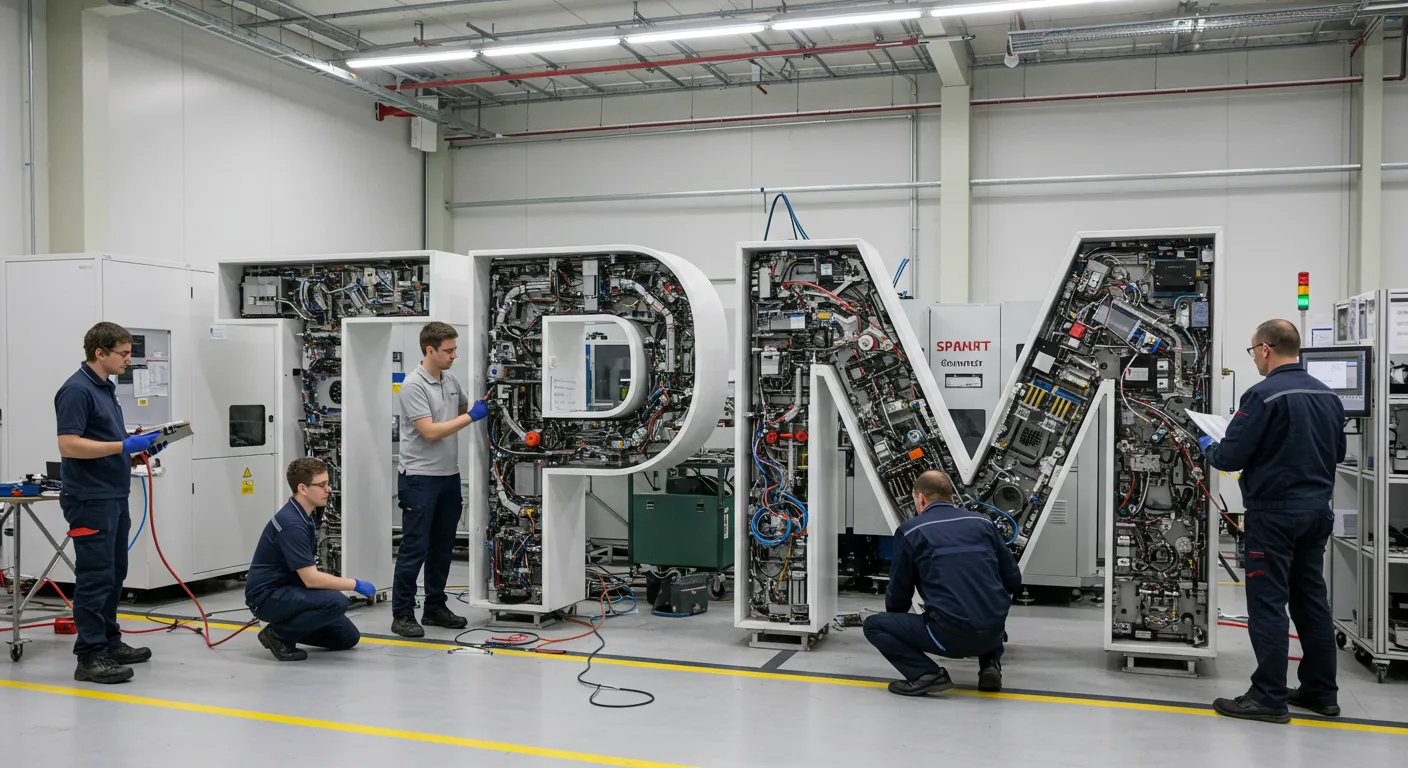In the dynamic and challenging industrial landscape, efficient maintenance management is a fundamental pillar for business success. It’s not just about “fixing what breaks,” but about implementing a proactive strategy that ensures asset reliability, minimizes costs, and maximizes productivity. Maintenance indicators are the compass that guides us on this path, providing valuable information about the performance of our equipment, the effectiveness of our processes, and the efficiency of our human team.
In this comprehensive article, we will delve into the world of maintenance indicators, exploring in detail the different types, their critical importance, and how their effective implementation, supported by technological tools, can transform asset management in any industry.
The Strategic Importance of Maintenance Indicators
Maintenance indicators are much more than simple numbers; they are a reflection of the health of our operations and the basis for strategic decision-making. Their importance lies in their ability to:
Provide Visibility and Control: Maintenance indicators allow us to have a clear and precise view of the state of our assets, identifying potential problems before they turn into crises. This gives us the necessary control to take corrective actions in a timely manner.
Drive Continuous Improvement: By monitoring maintenance indicators over time, we can identify trends, evaluate the effectiveness of our actions, and make adjustments to continuously improve our processes and results.
Optimize Resource Allocation: Maintenance indicators help us prioritize maintenance tasks, allocate resources efficiently, and avoid wasting time and money on activities that do not generate value.
Reduce Costs and Maximize Profitability: By preventing failures, optimizing the consumption of spare parts, and extending the useful life of assets, maintenance indicators directly contribute to cost reduction and increased profitability.
Ensure Safety and Sustainability: Maintenance indicators allow us to ensure that equipment operates in safe conditions, minimizing the risk of accidents and contributing to environmental sustainability by optimizing the consumption of energy and resources.
Types of Maintenance Indicators: A Detailed Analysis
There is a wide variety of maintenance indicators that can be used, and the choice of the most appropriate ones will depend on the specific needs of each organization. Below, we will explain some of the most important ones, with practical examples of their application in different industries:
Mean Time Between Failures (MTBF):
Definition: MTBF measures the average time an asset operates without failing. It is a key indicator of the reliability of a piece of equipment or system.
Importance: A high MTBF indicates greater reliability, while a low MTBF suggests that the asset is prone to failures. MTBF is used to predict when a failure is likely to occur and to schedule preventive maintenance proactively.
Examples of Use:
Mining Industry: In a mine in Chile, the MTBF of haul trucks is a critical indicator. A low MTBF can mean production delays and higher maintenance costs. By monitoring MTBF and analyzing the causes of failures, the company can implement improvements in truck maintenance and operation.
Manufacturing Industry: In a food factory in Mexico, the MTBF of packaging lines is essential. Failures in these lines can stop production and generate significant losses. By using MTBF to identify the most critical equipment and schedule preventive maintenance, the company can minimize downtime and ensure timely delivery of products.
Energy Industry: In a power generation plant in Colombia, the MTBF of turbines is a key indicator. Turbine failures can interrupt the power supply and have a negative impact on the economy. By monitoring MTBF and performing predictive maintenance, the company can avoid catastrophic failures and ensure the reliability of the electricity supply.
Mean Time To Repair (MTTR):
Definition: MTTR measures the average time it takes to repair an asset after a failure. It is an indicator of the efficiency of the maintenance team and the availability of spare parts.
Importance: A low MTTR indicates greater efficiency in repair, while a high MTTR suggests that the repair process is slow or inefficient. MTTR is used to identify areas for improvement in the maintenance process and to optimize spare parts management.
Examples of Use:
Transportation Industry: In a public transportation company in Argentina, the MTTR of buses is an important indicator. A high MTTR can mean that buses are out of service for longer, affecting service availability and passenger satisfaction. By analyzing the causes of MTTR and improving repair processes, the company can reduce bus downtime and improve service quality.
Healthcare Industry: In a hospital in Brazil, the MTTR of medical equipment is crucial. Failures in this equipment can put patients’ lives at risk. By monitoring MTTR and ensuring the availability of spare parts and trained personnel, the hospital can minimize equipment downtime and provide quality medical care.
Oil and Gas Industry: On an oil platform in the Caribbean Sea, the MTTR of drilling equipment is a critical indicator. Failures in this equipment can stop production and generate significant economic losses. By using MTTR to identify bottlenecks in the repair process and improve spare parts logistics, the company can reduce equipment downtime and optimize production.
Asset Availability:
Definition: Asset availability measures the percentage of time an asset is available for operation. It is an indicator of the overall reliability of the asset and the impact of maintenance on production.
Importance: High availability indicates that the asset is functioning correctly and is available when needed, while low availability suggests that the asset is frequently out of service. Availability is used to evaluate the effectiveness of the maintenance strategy and to identify assets that require more attention.
Examples of Use:
Food and Beverage Industry: In a food processing plant in Peru, the availability of production lines is essential. Failures in these lines can stop production and generate significant losses. By monitoring availability and analyzing the causes of downtime, the company can implement improvements in line maintenance and operation.
Chemical Industry: In a chemical plant in Colombia, the availability of reactors is a key indicator. Reactor failures can interrupt production and create safety risks. By using availability to identify the most critical equipment and schedule preventive maintenance, the company can minimize downtime and ensure the safety of operations.
Automotive Industry: In an automotive assembly plant in Mexico, the availability of welding robots is crucial. Failures in these robots can stop production and affect the quality of vehicles. By monitoring availability and performing predictive maintenance, the company can avoid catastrophic failures and ensure production efficiency.
Maintenance Cost:
Definition: Maintenance cost measures the total cost of maintenance, including labor, spare parts, materials, and other related expenses.
Importance: Maintenance cost is a key indicator of the efficiency of maintenance management. A high maintenance cost may indicate that maintenance processes are inefficient or that assets are failing frequently. Maintenance cost is used to control maintenance expenses, optimize the budget, and evaluate the return on investment in maintenance.
Examples of Use:
Hospitality Industry: In a hotel chain in the Caribbean, the maintenance cost of facilities is an important indicator. A high maintenance cost can affect the profitability of the hotels. By analyzing the components of maintenance cost and looking for opportunities to reduce expenses, the chain can improve its efficiency and profitability.
Construction Industry: In a construction company in Brazil, the maintenance cost of heavy machinery is crucial. Failures in this machinery can delay projects and generate significant economic losses. By monitoring maintenance cost and optimizing spare parts management and preventive maintenance, the company can reduce expenses and improve project profitability.
Telecommunications Industry: In a telecommunications company in Argentina, the maintenance cost of the telecommunications network is a key indicator. Network failures can interrupt services and affect customer satisfaction. By using maintenance cost to identify areas where expenses can be reduced and efficiency improved, the company can optimize its operations and improve its profitability.
Preventive Maintenance (PM) Compliance:
Definition: Preventive maintenance compliance measures the percentage of preventive maintenance tasks that are completed on time.
Importance: Preventive maintenance is essential to prevent failures and extend the useful life of assets. High PM compliance indicates that preventive maintenance is being carried out effectively, while low compliance suggests that preventive maintenance is being neglected. PM compliance is used to ensure that preventive maintenance is performed in a timely manner and to identify areas where maintenance planning and scheduling processes can be improved.
Examples of Use:
Pharmaceutical Industry: In a pharmaceutical company in Colombia, PM compliance of production equipment is crucial. Failures in this equipment can affect the quality of medicines and put patients’ health at risk. By monitoring PM compliance and ensuring that maintenance tasks are performed on time, the company can ensure product quality and patient safety.
Aerospace Industry: In an aircraft maintenance company in Brazil, PM compliance of aircraft is essential. Failures in aircraft can have catastrophic consequences. By using PM compliance to ensure that maintenance is performed according to safety standards, the company can ensure flight safety and aircraft reliability.
Rail Transportation Industry: In a rail transportation company in Mexico, PM compliance of trains is a key indicator. Failures in trains can cause delays and accidents. By monitoring PM compliance and ensuring that maintenance is performed in a timely manner, the company can ensure passenger safety and service efficiency.
Maintenance Backlog:
Definition: Maintenance backlog measures the amount of pending maintenance work.
Importance: A high maintenance backlog may indicate that the maintenance team is overloaded with work or that maintenance planning and scheduling processes are inefficient. A low maintenance backlog suggests that the maintenance team is working efficiently and that maintenance tasks are being completed on time. The maintenance backlog is used to assess the workload of the maintenance team, identify the need for additional resources, and optimize maintenance planning and scheduling processes.
Examples of Use:
Utilities Industry: In a utilities company in Argentina, the maintenance backlog of the water distribution network is an important indicator. A high backlog may mean that water leaks are not being repaired on time, leading to water losses and affecting the quality of service. By monitoring the backlog and allocating the necessary resources to repair leaks, the company can reduce water losses and improve service quality.
Shopping Center Industry: In a shopping center in Colombia, the maintenance backlog of the facilities is crucial. A high backlog may mean that repairs and maintenance of the facilities are not being carried out on time, affecting the customer experience. By monitoring the backlog and prioritizing maintenance tasks, the shopping center can ensure the comfort and safety of customers.
Amusement Park Industry: In an amusement park in Mexico, the maintenance backlog of the attractions is a key indicator. A high backlog may mean that the attractions are not available to visitors, affecting customer satisfaction. By monitoring the backlog and scheduling maintenance efficiently, the amusement park can ensure the availability of attractions and visitor satisfaction.
Leaving Behind Paper and Spreadsheets: A Necessary Change
In the digital age, managing maintenance with paper and spreadsheets is an obsolete and inefficient practice. These tools have significant limitations that hinder the effective management of maintenance indicators and the optimization of the maintenance strategy.
Some of the main limitations of paper and spreadsheets are:
- Inefficiency in Data Collection and Analysis: Collecting and analyzing data on paper and spreadsheets are manual processes that consume a lot of time and effort.
- Propensity to Errors: Manual data entry is prone to human errors, which can affect the accuracy of maintenance indicators and decision-making.
- Lack of Visibility and Control: Paper and spreadsheets make it difficult to visualize maintenance indicators and identify trends and potential problems.
- Difficulty in Collaboration: Paper and spreadsheets hinder collaboration between different members of the maintenance team and other departments of the organization.
- Lack of Integration: Paper and spreadsheets do not integrate with other business systems, making it difficult to exchange information and automate processes.
The Transformative Role of Software like HxGN EAM
Effective management of maintenance indicators requires a powerful tool that allows data to be collected, analyzed, and visualized efficiently. EAM (Enterprise Asset Management) software like HxGN EAM is the ideal solution.
Conclusion: The Future of Maintenance
Maintenance indicators are essential tools for optimizing asset management and ensuring the efficiency and profitability of operations. Their effective implementation, supported by EAM software like HxGN EAM, allows companies to:
- Improve Asset Reliability: By preventing failures and optimizing maintenance, companies can increase the availability and reliability of their assets.
- Reduce Maintenance Costs: By optimizing the consumption of spare parts, minimizing unplanned downtime, and extending the useful life of assets, companies can significantly reduce maintenance costs.
- Increase Productivity: By ensuring that assets are available and functioning correctly, companies can increase the productivity and efficiency of their operations.
- Improve Safety: By identifying and correcting potential problems before they become failures, companies can reduce the risk of accidents and ensure the safety of their employees and customers.
- Contribute to Sustainability: By optimizing energy and resource consumption and reducing waste generation, companies can minimize their environmental impact and contribute to the planet’s sustainability.
- Drive Innovation: By providing valuable information about asset performance and maintenance effectiveness, maintenance indicators can help companies identify opportunities for innovation and continuous improvement.
- Ensure Competitiveness: In an increasingly competitive global market, efficient maintenance management is a key factor for business success. By implementing maintenance indicators and EAM software, companies can optimize their operations, reduce costs, and improve their competitiveness.
Are you ready to take your maintenance management to the next level? Contact us today to discover how HxGN EAM and other innovative technologies can help you optimize your operations, reduce costs, and improve your competitiveness!






